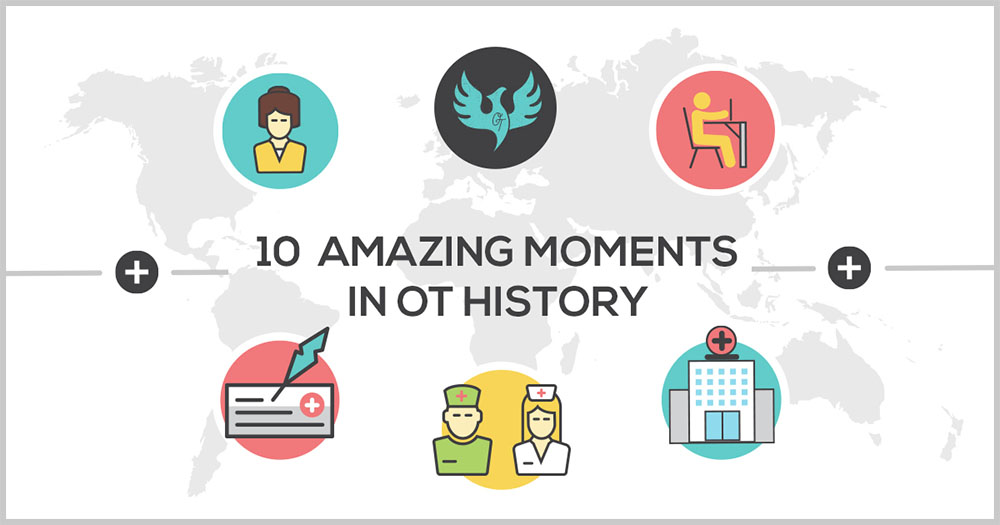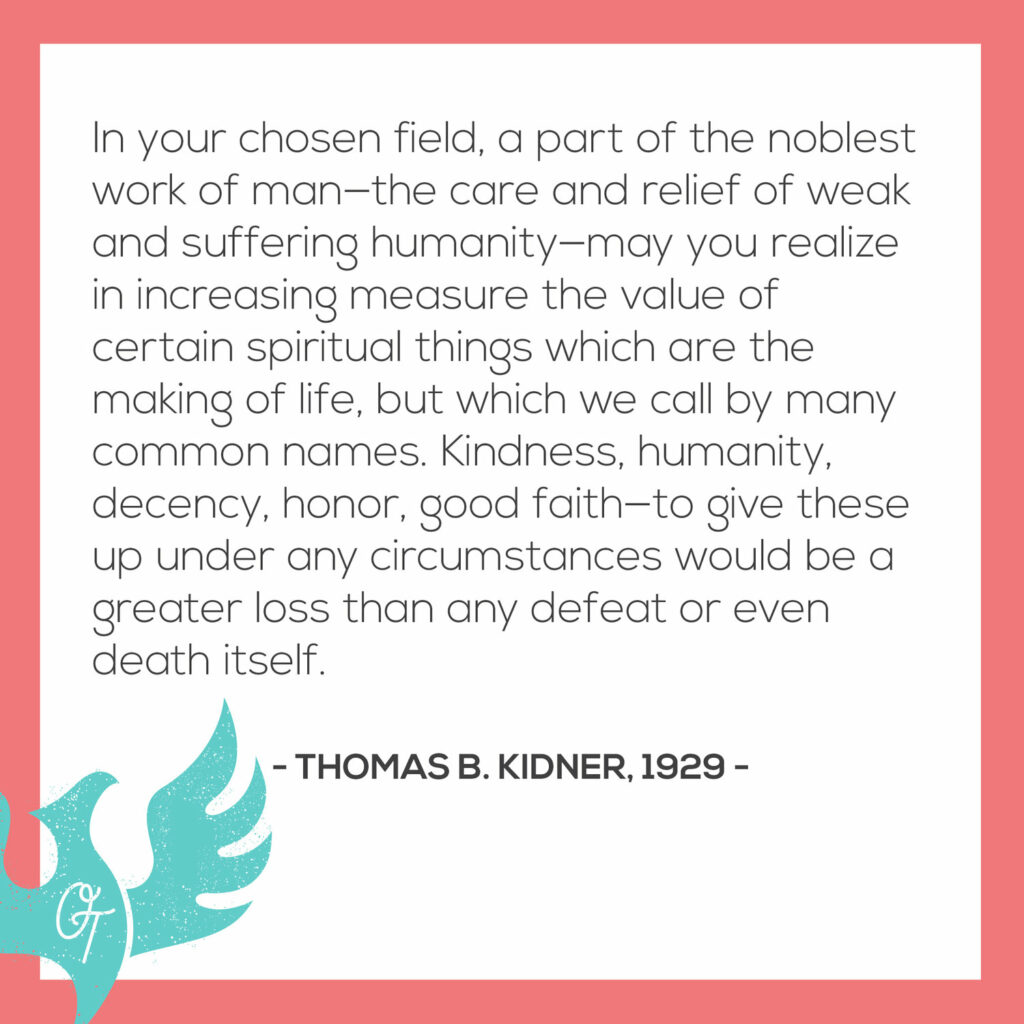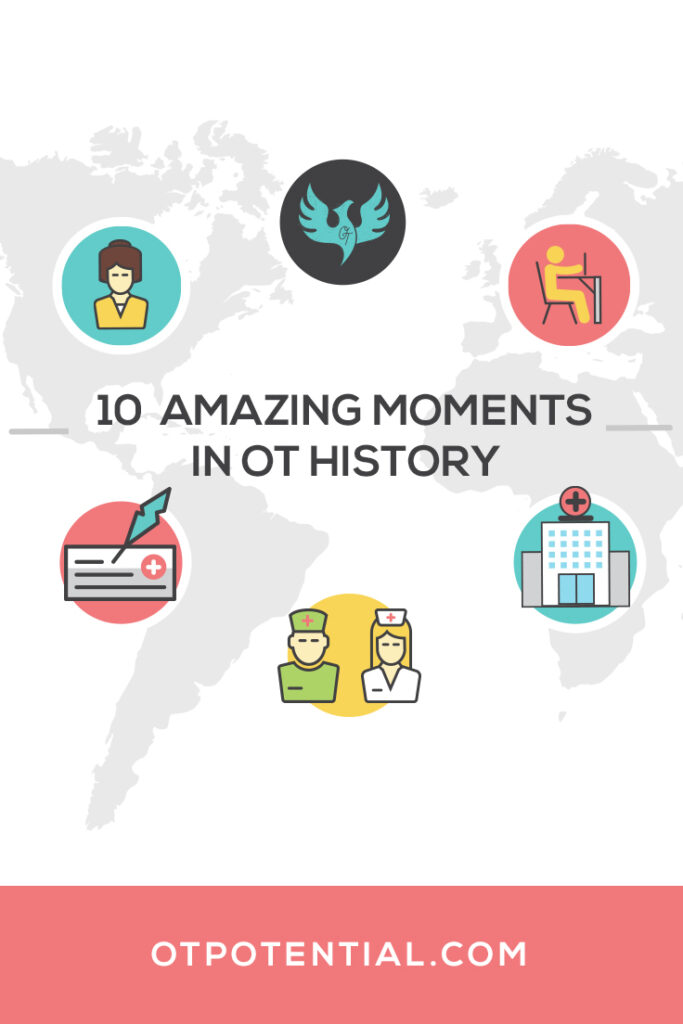
In 1917, a small group met on March 15-18th in Clifton Springs, New York, and established The National Society for the Promotion of Occupational Therapy. In the United States, we celebrate this as the official start of our profession.
In 2017, we celebrated the centennial of occupational therapy. In this post, we look back over the past century and celebrate some of the best moments from occupational therapy history.
My 10 Favorite Moments in OT History
1.) The founders included three men and three women, an equal gender division.
In 1917, three men and three women voted into existence a national OT association. This was three years before women were allowed to vote in federal elections!
Our profession still has much work to do in ensuring that our workforce reflects the clientele that we serve, but I am thankful for this inspiration from our origin.
Founders included:
- Eleanor Clarke Slagle
- George Edward Barton
- Dr. William Rush Dunton, Jr.
- Susan Cox Johnson
- Thomas Bessell Kidner
- Isabel G. Newton
2.) The name “occupational therapy” is chosen.
I’ve come to believe that occupational therapy’s name is pure genius.
When the name was settled on, it held together several different movements. The inclusion of “occupation” in our name encompassed the following:
- a rejection of rest-cure for tuberculosis,
- a rejection of having patients passively languish in institutions,
- and an affirmation that the goal of care should be for patients to re-enter into society.
The value placed on occupations also aligned the new profession with the Arts and Crafts movement, which prized the value of traditional craftsmanship as factory production was on the rise.
The inclusion of “therapy” situated our work squarely in the medical field. This was important because women’s work in healthcare was just starting to be regarded as professional work (versus private acts of charity.)
To me, our name is a source of inspiration as our profession continues to navigate the many forces that influence our care.
3.) The phoenix is envisioned as the symbol of occupational therapy.

The phoenix is a mythical bird that is reborn from its own ashes (think: Harry Potter). George Edward Barton foresaw this as the symbol of our work and made it the symbol of Consolation House, where he practiced occupational therapy. Under the image of the bird was the tagline “Beauty from Ashes.”
Today the phoenix can be seen on the emblem of OT organizations around the world, including in Hong Kong, and Australia.
4.) OT’s unique role in pediatrics is established early.
Pediatric occupational therapy has its own unique history, that seems to be under-explored and under-celebrated. I hope to learn more about this history, but for now, I want to give the spotlight to the Curative Workshop that was established in 1919 and is one of the earliest examples of occupational therapy methods being used to serve children with disabilities.
5.) Occupational therapy responds to needs during WWI.
The young profession was quickly drawn into assisting with the war effort. The army began its first use of OT in 1918 at Walter Reed Hospital. Bedridden patients knitted and patients who were ambulatory participated in chair caning, woodworking, printing, and rug making. (Ron Swanson would have been proud.)
Both world wars helped establish occupational therapy’s role in orthopedic care.
6.) Eleanor Roosevelt speaks at Eleanor Clarke Slagle’s retirement reception.
Eleanor Clarke Slagle is considered the “mother of occupational therapy.” She served in elected offices of the Society for the Promotion of Occupational Therapy from 1917-1937.
Slagle was among a new generation of professional women. For me, nothing situates her place in history better than picturing Eleanor Roosevelt speaking at her retirement celebration in 1937.
I do not know the content of Roosevelt’s remarks other than what was summarized in an AOTF newsletter from 2012.
“During her remarks, Mrs. Roosevelt lauded the untiring work of Eleanor Clarke Slagle, but could not resist the temptation to speak on the professional activities of women and the importance of advancing the cause of women in society.”
(If anyone has access to her full remarks, please let me know!)
7.) A beautiful graduation speech is composed.

I love reading the soaring rhetoric from the founders of occupational therapy. Their passion for establishing our profession is so evident in their writing. This expert from a graduation speech delivered in 1929 by Thomas Kidner is my favorite example.
In your chosen field, a part of the noblest work of man—the care and relief of weak and suffering humanity—may you realize in increasing measure the value of certain spiritual things which are the making of life, but which we call by many common names. Kindness, humanity, decency, honor, good faith—to give these up under any circumstances would be a greater loss than any defeat or even death itself.
8.) The World Federations of Occupational Therapists (WFOT) is established.
WFOT was established in 1952 by OT associations from 10 countries.
Today, WFOT has 92 Member Organizations and represents approximately 480,000 occupational therapists around the world. Here’s our long list of OT associations from around world!

9.) Sigourney Weaver plays an OT!
Okay. This might just be a personal favorite since I love Sigourney.
Unfortunately, Sigourney’s character in the 1988 movie “Gorillas In The Mist” isn’t actively working as an OT, but the historical figure was trained as an occupational therapist so I’m going to count it.
Ms. Weaver plays Dian Fossey, who trained and worked as an occupational therapist before moving to Rwanda to study mountain gorillas. Be warned: this is not the feel good movie I was expecting when I checked it out at my local video store a decade ago. There is scandal involved as well as a tragic murder mystery.
(The only other OT in pop culture I know of is Matt Damon in Downsizing. If you know of any let me know!)
10.) The OT services YOU are providing!
While it may not have made the history books yet, the care that you provide individual clients is truly what makes our profession great. May we continue to learn from our past and look ahead with our focus on one thing: providing the best care possible.
Free OT Month Toolkit
In our post 10 Ideas for Occupational Therapy Month, we include a free OT Month toolkit with downloadable files and printable handouts. In this kit, you will find a PDF with a history of OT timeline you can share to promote our profession!
Additional Occupational Therapy History Resources
These moments only scratch the surface of occupational therapy history. If you are interested in reading more, I recommend othistory.com with posts written by Chris Alterio and the OT Centennial website, along with the following reading:
Friedland J. Restoring the spirit: the beginnings of occupational therapy in Canada, 1890-1930. Montréal: McGill-Queen’s University Press; 2011.
Peloquin SM. Occupational Therapy Service: Individual and Collective Understandings of the Founders, Part 1. American Journal of Occupational Therapy. 1991;45(4):352-360. doi:10.5014/ajot.45.4.352.
Peloquin SM. Occupational Therapy Service: Individual and Collective Understandings of the Founders, Part 2. American Journal of Occupational Therapy. 1991;45(8):733-744. doi:10.5014/ajot.45.8.733.
Quiroga VAM. Occupational Therapy: the first 30 years: 1900 to 1930. Bethesda, MD: The American Occupational Therapy Association; 1995.


7 replies on “10 Amazing Moments in OT History”
Thank you very much for this! Very inspiring.
So glad to hear it was inspiring! It was a fun list to put together!
Thank you for creating and sharing this. It’s a great way to remind ourselves where it all began. We give a proud nod of gratitude to the founders of OT.
The profession has developed radically and diversely in 100 years.
I absolutely love Thomas B Kidner’s speech. The more I read it the more I really relate to the human aspect of our role. How reconnecting people to their own valued occupations can literally save their lives. Or make it a life rather than an existence.
I wonder what the founders would think about it all now?! Or how fabulous it is that an American OT can reach a U.K. OT to share inspirational stories about the origins, with great ease via social media.
Imagine another 100 years from now, what wonderful things will be achieved along the way!
Louise
Thank you so much for this comment, Louise! I agree that is awesome to think about where our profession is today from the founder’s perspective. I see our profession becoming more and more globally connected, which is something they may have hoped for, but have been unable to image the means by which we are doing it today.
I’ve also been thinking about the next 100 years of OT and hoping to do a blog post on it one of these days. We have much to learn from our past and I believe that time spent reflecting on it will help us enter the next 100 with clear eyes.
Best to you from across the pond,
Sarah
It is hard NOT to be biased as an OT. When I first entered college, I fell on OT accidentally and really didn’t fully understand what it was. 25 years later, the relevance of occupation is SO dynamic it still amazes all that we are able to address. And to think our founding "Parents" had the genius to figure it all out so long ago. Just in awe!!! Thanks for sharing!
Great article. OT helps people with physical, sensory, or cognitive problems. This branch of healthcare includes therapeutic exercises and activities to maximize functional recovery. Contact North Texas Hand Center for occupational therapy in Dallas, TX.
Great article. I am a big military buff and love how our profession was so utilized in WWI. I am up now with insomnia and just started the movie “Gorillas in the Mist”.